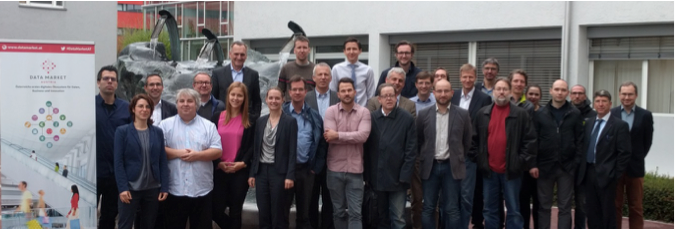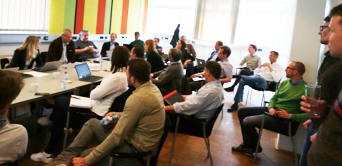The second plenary meeting of Data Market Austria took place at the beginning of April in Salzburg. A perfect time to catch up on the latest developments in a project with 17 partners distributed over the entire Austrian landscape. And by landscape I of course mean both geographical (from the mountains of Salzburg to the plains of Vienna) but also professional (from the research institutions like the RSA to the large multinationals like Siemens, and from small to large companies).
The two-days long event took place at the TechnoZ center, where the consortium managed to make full usage of all the seminar rooms that the center had available. From small work package meetings with just a few people, working hard on concrete tasks to deliver, to large multi-workpackage discussions where even the larger seminar room seems bursting with people, and, of course, ideas.

The plenary started on Wednesday morning with a joint session where the Project Coordinator, Allan Hanbury, gave an overview of the status of the project. And there were certainly some extremely interesting points already: the Data Market Austria, only in its 6 month, had already reached our European partners as well as the far-East, with presentations in Germany and China as part of official delegations.
I then had the pleasure of presenting the technical integration efforts of the past six months. Not an easy task showing in 30 minutes all that partners had done and all the progress that had been made.
Martin Kaltenböck and Peter Parycek then presented community involvement developments and, respectively, the discussions going on around the legal aspects of data sharing in Data Market Austria. Martin confirmed Allan’s initial statement that DMA has already generated a substantial amount of interest in the local community and many actors are already interested in actively participating in the Market.
Finally, the first session of the plenary ended with progress reports from the two Pilot areas: mobility and earth observation. To some extent I envy both Christian Federspiel and Werner Mucke, as the Pilot presentations tend to be much more attractive then technology or legal reports. This was no exception, and, among others, participants got a glimpse into what a final product, integrating different data from different providers, addressing a real need, would look like.

The rest of the plenary was scheduled such that work packages first had the time to meet internally and discuss items specific to their own agenda, followed on the second day by cross-work- package meetings, where the aim was to make sure that the internal agenda matched that of other work packages and of other partners. Finally, another round of WP-internal meetings ensured that the items taken from the cross-WP meetings found their place in the internal planning of each work package.
The plenary concluded with a meeting of WP-leaders, followed by a public event organized at the WIFI Salzburg. But about that in another article here in the same newsletter. Overall, some very intense 48h, particularly gratifying to me to see that the entire project is moving ahead and all partners see the potential that this common effort has, for each participating company individually, but also for Austria as a leader in innovation.


